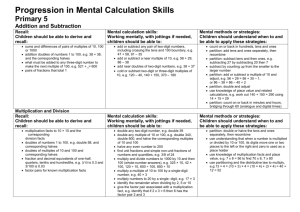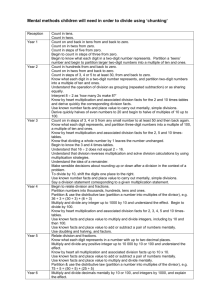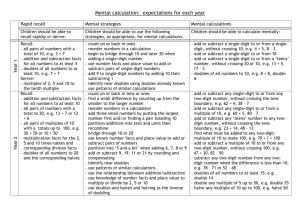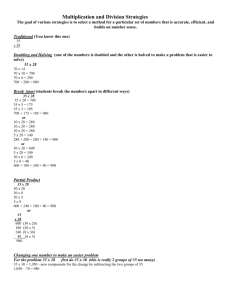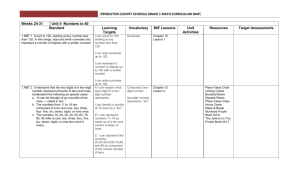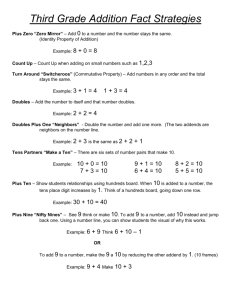Mental maths objectives and coverage each year
advertisement
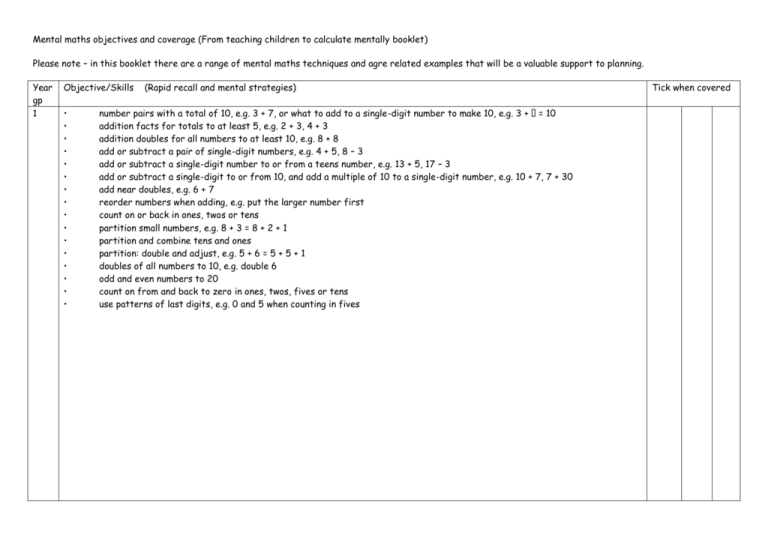
Mental maths objectives and coverage (From teaching children to calculate mentally booklet) Please note – in this booklet there are a range of mental maths techniques and agre related examples that will be a valuable support to planning. Year gp 1 Objective/Skills • • • • • • • • • • • • • • • • (Rapid recall and mental strategies) number pairs with a total of 10, e.g. 3 + 7, or what to add to a single-digit number to make 10, e.g. 3 + = 10 addition facts for totals to at least 5, e.g. 2 + 3, 4 + 3 addition doubles for all numbers to at least 10, e.g. 8 + 8 add or subtract a pair of single-digit numbers, e.g. 4 + 5, 8 – 3 add or subtract a single-digit number to or from a teens number, e.g. 13 + 5, 17 – 3 add or subtract a single-digit to or from 10, and add a multiple of 10 to a single-digit number, e.g. 10 + 7, 7 + 30 add near doubles, e.g. 6 + 7 reorder numbers when adding, e.g. put the larger number first count on or back in ones, twos or tens partition small numbers, e.g. 8 + 3 = 8 + 2 + 1 partition and combine tens and ones partition: double and adjust, e.g. 5 + 6 = 5 + 5 + 1 doubles of all numbers to 10, e.g. double 6 odd and even numbers to 20 count on from and back to zero in ones, twos, fives or tens use patterns of last digits, e.g. 0 and 5 when counting in fives Tick when covered 2 • addition and subtraction facts for all numbers up to at least 10, e.g. 3 + 4, 8 – 5 • number pairs with totals to 20 • all pairs of multiples of 10 with totals up to 100, e.g. 30 + 70, or 60 + = 100 • what must be added to any two-digit number to make the next multiple of 10, e.g. 52 + = 60 • addition doubles for all numbers to 20, e.g. 17 + 17 and multiples of 10 to 50, e.g. 40 + 40 • addition and subtraction facts for all numbers up to at least 10, e.g. 3 + 4, 8 – 5 • number pairs with totals to 20 • all pairs of multiples of 10 with totals up to 100, e.g. 30 + 70, or 60 + = 100 • what must be added to any two-digit number to make the next multiple of 10, e.g. 52 + = 60 • addition doubles for all numbers to 20, e.g. 17 + 17 and multiples of 10 to 50, e.g. 40 + 40 • reorder numbers when adding • partition: bridge through 10 and multiples of 10 when adding and subtracting • partition and combine multiples of tens and ones • use knowledge of pairs making 10 • partition: count on in tens and ones to find the total • partition: count on or back in tens and ones to find the difference • partition: add a multiple of 10 and adjust by 1 • partition: double and adjust • doubles of all numbers to 20, e.g. double 13, and corresponding halves • doubles of multiples of 10 to 50, e.g. double 40, and corresponding halves • multiplication facts for the 2, 5 and 10 times-tables, and corresponding division facts • odd and even numbers to 100 • double any multiple of 5 up to 50, e.g. double 35 • halve any multiple of 10 up to 100, e.g. halve 90 • find half of even numbers to 40 • find the total number of objects when they are organised into groups of 2, 5 or 10 • partition: double the tens and ones separately, then recombine • use knowledge that halving is the inverse of doubling and that doubling is equivalent to multiplying by two • use knowledge of multiplication facts from the 2, 5 and 10 times-tables, e.g. recognise that there are 15 objects altogether because there are three groups of five 3 • addition and subtraction facts for all numbers to 20, e.g. 9 + 8, 17 – 9, drawing on knowledge of inverse operations • sums and differences of multiples of 10, e.g. 50 + 80, 120 – 90 • pairs of two-digit numbers with a total of 100, e.g. 32 + 68, or 32 + = 100 • addition doubles for multiples of 10 to 100, e.g. 90 + 90 • add and subtract groups of small numbers, e.g. 5 – 3 + 2 • add or subtract a two-digit number to or from a multiple of 10, e.g. 50 + 38, 90 – 27 • add and subtract two-digit numbers e.g. 34 + 65, 68 – 35 • add near doubles, e.g. 18 + 16, 60 + 70 • reorder numbers when adding • identify pairs totalling 10 or multiples of 10 • partition: add tens and ones separately, then recombine • partition: count on in tens and ones to find the total • partition: count on or back in tens and ones to find the difference • partition: add or subtract 10 or 20 and adjust • partition: double and adjust • partition: count on or back in minutes and hours, bridging through 60 (analogue times) • multiplication facts for the 2, 3, 4, 5, 6 and 10 times-tables, and corresponding division facts • doubles of multiples of 10 to 100, e.g. double 90, and corresponding halves • multiplication facts for the 2, 3, 4, 5, 6 and 10 times-tables, and corresponding division facts • doubles of multiples of 10 to 100, e.g. double 90, and corresponding halves • partition: when doubling, double the tens and ones separately, then recombine • partition: when halving, halve the tens and ones separately, then recombine • use knowledge that halving and doubling are inverse operations • recognise that finding a unit fraction is equivalent to dividing by the denominator and use knowledge of division facts • recognise that when multiplying by 10 or 100 the digits move one or two places to the left and zero is used as a place holder 4 sums and differences of pairs of multiples of 10, 100 or 1000 • addition doubles of numbers 1 to 100, e.g. 38 + 38, and the corresponding halves • what must be added to any three-digit number to make the next multiple of 100, e.g. 521 + = 600 • pairs of fractions that total 1 add or subtract any pair of two-digit numbers, including crossing the tens and 100 boundary, e.g. 47 + 58, 91 – 35 add or subtract a near multiple of 10, e.g. 56 + 29, 86 – 38 add near doubles of 2 digit numbers e.g. 38 + 37 add or subtract two-digit or three-digit multiples of 10, e.g. 120 – 40, 140 + 150, 370 – 180 • count on or back in hundreds, tens and ones • partition: add tens and ones separately, then recombine • partition: subtract tens and then ones, e.g. subtracting 27 by subtracting 20 then 7 • subtract by counting up from the smaller to the larger number • partition: add or subtract a multiple of 10 and adjust, e.g. 56 + 29 = 56 + 30 – 1, or 86 – 38 = 86 – 40 + 2 • partition: double and adjust • use knowledge of place value and related calculations, e.g. work out 140 + 150 = 290 using 14 + 15 = 29 • partition: count on or back in minutes and hours, bridging through 60 (analogue and digital times) multiplication facts to 10 × 10 and the corresponding division facts • doubles of numbers 1 to 100, e.g. double 58, and corresponding halves • doubles of multiples of 10 and 100 and corresponding halves • fraction and decimal equivalents of one-half, quarters, tenths and hundredths, e.g. 3 10 is 0.3 and 3 100 is 0.03 • factor pairs for known multiplication facts double any two-digit number, e.g. double 39 • double any multiple of 10 or 100, e.g. double 340, double 800, and halve the corresponding multiples of 10 and 100 • halve any even number to 200 • find unit fractions and simple non-unit fractions of numbers and quantities, e.g. 3 8 of 24 • multiply and divide numbers to 1000 by 10 and then 100 (whole-number answers), e.g. 325 × 10, 42 × 100, 120 ÷ 10, 600 ÷ 100, 850 ÷ 10 • multiply a multiple of 10 to 100 by a single-digit number, e.g. 40 × 3 • multiply numbers to 20 by a single-digit, e.g. 17 × 3 • identify the remainder when dividing by 2, 5 or 10 • give the factor pair associated with a multiplication fact, e.g. identify that if 2 x 3 = 6 then 6 has the factor pair 2 and 3 • partition: double or halve the tens and ones separately, then recombine • use understanding that when a number is multiplied or divided by 10 or 100, its digits move one or two places to the left or the right and zero is used as a place holder • use knowledge of multiplication facts and place value, e.g. 7 x 8 = 56 to find 70 x 8, 7 x 80 • use partitioning and the distributive law to multiply, e.g. 13 × 4 = (10 + 3) × 4 = (10 × 4) + (3 × 4) = 40 + 12 = 52 5 sums and differences of decimals, e.g. 6.5 + 2.7, 7.8 – 1.3 • doubles and halves of decimals, e.g. half of 5.6, double 3.4 • what must be added to any four-digit number to make the next multiple of 1000, e.g. 4087 + = 5000 • what must be added to a decimal with units and tenths to make the next whole number, e.g. 7.2 + = 8 Add or subtract a pair or 2 digit numbers or 3 digit multiples of 10 e.g. 38 + 86, 620 – 380, 350+ 360 add or subtract a near multiple of 10 or 100 to any two-digit or three-digit number, e.g. 235 + 198 • find the difference between near multiples of 100, e.g. 607 – 588, or of 1000, e.g. 6070 – 4087 • add or subtract any pairs of decimal fractions each with units and tenths, e.g. 5.7 + 2.5, 6.3 – 4.8 count on or back in hundreds, tens, ones and tenths • partition: add hundreds, tens or ones separately, then recombine • subtract by counting up from the smaller to the larger number • add or subtract a multiple of 10 or 100 and adjust • partition: double and adjust • use knowledge of place value and related calculations, e.g. 6.3 – 4.8 using 63 – 48 • partition: count on or back in minutes and hours, bridging through 60 (analogue and digital times) squares to 10 × 10 • division facts corresponding to tables up to 10 × 10, and the related unit fractions, e.g. 7 × 9 = 63 so one-ninth of 63 is 7 and one-seventh of 63 is 9 • percentage equivalents of one-half, one-quarter, three-quarters, tenths and hundredths • factor pairs to 100 • multiply and divide two-digit numbers by 4 or 8, e.g. 26 × 4, 96 ÷ 8 • multiply two-digit numbers by 5 or 20, e.g. 320 × 5, 14 × 20 • multiply by 25 or 50, e.g. 48 × 25, 32 × 50 • double three-digit multiples of 10 to 500, e.g. 380 × 2, and find the corresponding halves, e.g. 760 ÷ 2 • find the remainder after dividing a two-digit number by a single-digit number, e.g. 27 ÷ 4 = 6 R 3 • multiply and divide whole numbers and decimals by 10, 100 or 1000, e.g. 4.3 × 10, 0.75 × 100, 25 ÷ 10, 673 ÷ 100, 74 ÷ 100 • multiply pairs of multiples of 10, e.g. 60 × 30, and a multiple of 100 by a single digit number, e.g. 900 × 8 • divide a multiple of 10 by a single-digit number (whole number answers) e.g. 80 ÷ 4, 270 ÷ 3 • find fractions of whole numbers or quantities, e.g. 2 3 of 27, 4 5 of 70 kg • find 50%, 25% or 10% of whole numbers or quantities, e.g. 25% of 20 kg, 10% of £80 find factor pairs for numbers to 100, e.g. 30 has the factor pairs 1 × 30, 2 × 15, 3 × 10 and 5 × 6multiply or divide by 4 or 8 by repeated doubling or halving • form an equivalent calculation, e.g. to multiply by 5, multiply by 10, then halve; to multiply by 20, double, then multiply by 10 • use knowledge of doubles/halves and understanding of place value, e.g. when multiplying by 50 multiply by 100 and divide by 2 • use knowledge of division facts, e.g. when carrying out a division to find a remainder • use understanding that when a number is multiplied or divided by 10 or 100, its digits move one or two places to the left or the right relative to the decimal point, and zero is used as a place holder • • • use knowledge of multiplication and division facts and understanding of place value, e.g. when calculating with multiples of 10 use knowledge of equivalence between fractions and percentages, e.g. to find 50%, 25% and 10% use knowledge of multiplication and division facts to find factor pairs 6 addition and subtraction facts for multiples of 10 to 1000 and decimal numbers with one decimal place, e.g. 650 + = 930, – 1.4 = 2.5 • what must be added to a decimal with units, tenths and hundredths to make the next whole number, e.g. 7.26 + = 8 add or subtract pairs of decimals with units, tenths or hundredths, e.g. 0.7 + 3.38 • find doubles of decimals each with units and tenths, e.g. 1.6 + 1.6 • add near doubles of decimals, e.g. 2.5 + 2.6 • add or subtract a decimal with units and tenths, that is nearly a whole number, e.g. 4.3 + 2.9, 6.5 – 3.8 count on or back in hundreds, tens, ones, tenths and hundredths • use knowledge of place value and related calculations, e.g. 680 + 430, 6.8 + 4.3, 0.68 + 0.43 can all be worked out using the related calculation 68 + 43 • use knowledge of place value and of doubles of two-digit whole numbers • partition: double and adjust • partition: add or subtract a whole number and adjust, e.g. 4.3 + 2.9 = 4.3 + 3 – 0.1, 6.5 – 3.8 = 6.5 – 4 + 0.2 • partition: count on or back in minutes and hours, bridging through 60 (analogue and digital times, 12-hour and 24-hour clock) Year 6 • squares to 12 × 12 • squares of the corresponding multiples of 10 • prime numbers less than 100 • equivalent fractions, decimals and percentages for hundredths, e.g. 35% is equivalent to 0.35 or 35 100 multiply pairs of two-digit and single-digit numbers, e.g. 28 × 3 • divide a two-digit number by a single-digit number, e.g. 68 ÷ 4 • divide by 25 or 50, e.g. 480 ÷ 25, 3200 ÷ 50 • double decimals with units and tenths, e.g. double 7.6, and find the corresponding halves, e.g. half of 15.2 • multiply pairs of multiples of 10 and 100, e.g. 50 × 30, 600 × 20 • divide multiples of 100 by a multiple of 10 or 100 (whole number answers), e.g. 600 ÷ 20, 800 ÷ 400, 2100 ÷ 300 • multiply and divide two-digit decimals such as 0.8 × 7, 4.8 ÷ 6 • find 10% or multiples of 10%, of whole numbers and quantities, e.g. 30% of 50 ml, 40% of £30, 70% of 200 g • simplify fractions by cancelling • scale up and down using known facts, e.g. given that three oranges cost 24p, find the cost of four oranges • identify numbers with odd and even numbers of factors and no factor pairs other than 1 and themselves partition: use partitioning and the distributive law to divide tens and ones separately, e.g. 92 ÷ 4 = (80 + 12) ÷ 4 = 20 + 3 = 23 • form an equivalent calculation, e.g. to divide by 25, divide by 100, then multiply by 4; to divide by 50, divide by 100, then double • use knowledge of the equivalence between fractions and percentages and the relationship between fractions and division • recognise how to scale up or down using multiplication and division, e.g. if three oranges cost 24p: one orange costs 24 ÷ 3 = 8p four oranges cost 8 × 4 = 32p • Use knowledge of multiplication and division facts to identify factor pairs and numbers with only two factors
